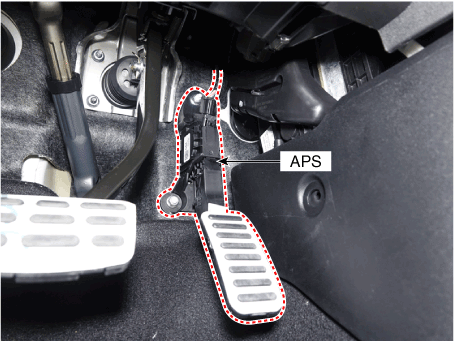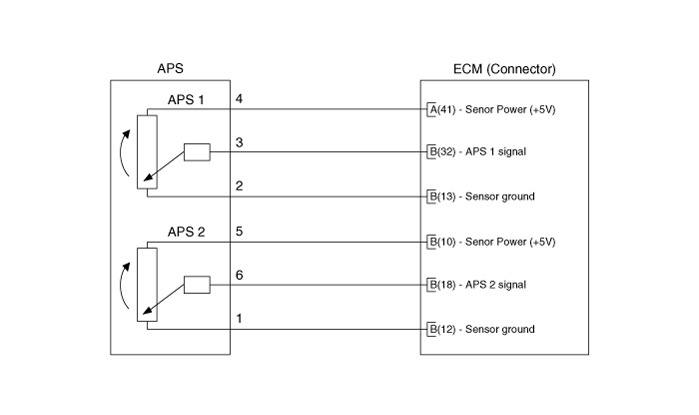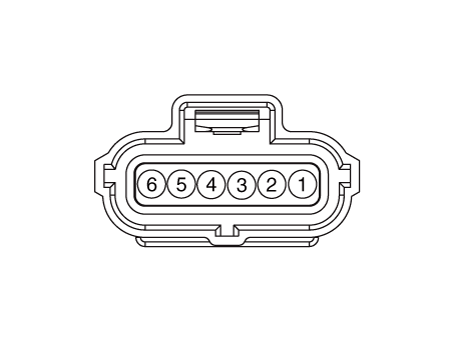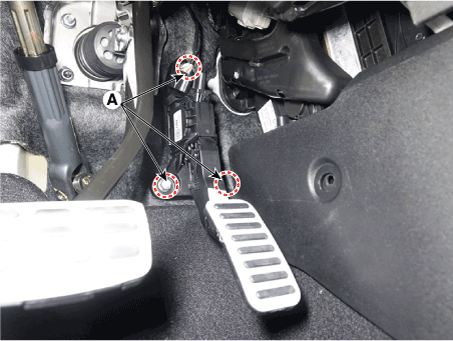Hyundai Elantra: Engine Control System / Accelerator Position Sensor (APS)
Hyundai Elantra (CN7) 2021-2025 Service Manual / Engine Control / Fuel System / Engine Control System / Accelerator Position Sensor (APS)
Description and operation
| Description |
Accelerator Position Sensor (APS) is installed on the accelerator pedal module and detects the rotation angle of the accelerator pedal. The APS is one of the most important sensors in engine control system, so it consists of the two sensors which adapt individual sensor power and ground line. The second sensor monitors the first sensor and its output voltage is half of the first one. If the ratio of the sensor 1 and 2 is out of the range (approximately 1/2), the diagnostic system judges that it is abnormal.

Specifications
| Specification |
|
Accelerator Position
|
Output Voltage [V]
| |
|
APS1
|
APS2
| |
| C.T | 0.7 - 0.8 | 0.33 - 0.43 |
| W.O.T | 3.98 - 4.22 | 1.93 - 2.17 |
Schematic diagrams
| Circuit Diagram |

Harness Connector

Repair procedures
| Inspection |
| 1. | Connect the diagnostic tool on the Data Link Connector (DLC). |
| 2. | Switch "ON" the ignition. |
| 3. | Measure the output voltage of the APS 3 and 6 at C.T and W.O.T.
|
| Removal |
| 1. | Turn ignition switch OFF and disconnect the battery negative (-) terminal. |
| 2. | Disconnect the accelerator position sensor connector (A).
|
| 3. | Remove the accelerator pedal module after loosening the nut (A).
|
| Installation |
| 1. | Install in the reverse order of removal. |
 Heated Oxygen Sensor (HO2S)
Heated Oxygen Sensor (HO2S)
Description and operation
DescriptionHeated Oxygen Sensor (HO2S) consists of the zirconium and the alumina and is installed on upstream and downstream of the Manifold Catalyst Converter (MCC)...
 CVVT Oil Temperature Sensor (OTS)
CVVT Oil Temperature Sensor (OTS)
Description and operation
DescriptionContinuous Variable Valve Timing (CVVT) system advances or retards the valve timing of the intake and exhaust valve in accordance with the ECM control signal which is calculated by the engine speed and load...
Other information:
Hyundai Elantra (CN7) 2021-2025 Owner's Manual: Limitations of the function
Forward Collision-Avoidance Assist may not operate normally, OR the function may operate unexpectedly under the following circumstances: The detecting sensor or the surroundings are contaminated or damaged The temperature around the front view camera is high or low The camera lens is contaminated due to tinted, filmed or coated windshield, damaged glass, or stuck of foreign mate..
Hyundai Elantra (CN7) 2021-2025 Owner's Manual: Remote start
You can start the engine and turn on the climate system by pressing the remote start button (5) outside the vehicle. To start and stop engine remotely : 1. Press the door lock button (1), and then the hazard warning lights blink once to alert you. 2. Press the Remote Start button (5) for more than 2 seconds to start the engine within 4 seconds after pressing the door lock button (1). 3. If ..
Copyright © 2025 www.helantra7.com



.png)